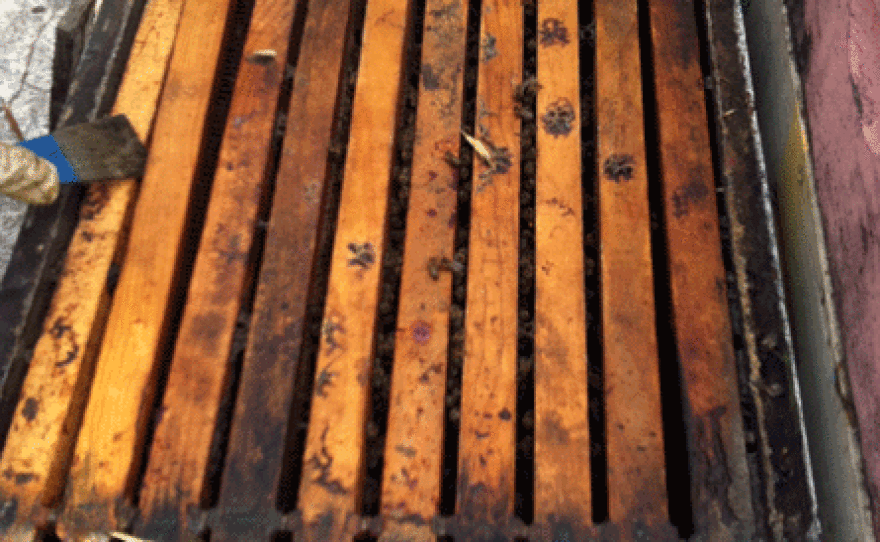By Julie Grant for The Environment Report
Michigan beekeepers are continuing to lose huge numbers of bees. They join beekeepers from around the country – and the world – who have been dealing with what’s called Colony Collapse Disorder. It’s been around for five years now. Julie Grant visited with some beekeepers, and reports that scientists and the government don’t agree on what should be done to help them. Here's her story:
Ted Elk is checking out some of his hives. They’re on the backside of a corn field, tucked away in the brush. The colorful boxes are stacked on top of each other.
Some hives are buzzing with activity. He pulls out a comb and scrapes the side:
“And that is all goldenrod honey. See how yellow that is?”
I want to eat it. It’s almost irresistible. But not all the hives look this good.
“Here’s one that’s not gonna make it through winter. It’s light, there’s no bees, there’s no weight to it.”
There’s honey on the comb. But almost no bees.
Elk suspects this hive has colony collapse disorder. There aren’t dead bees around. They’re just gone.
Elk has seen this before. Last winter, he lost 250 hives – and thousands of dollars. When Elk first started keeping bees, he might lose five or six percent in the winter. But nationwide, a 30 percent winter bee loss is average nowadays.
Researchers still aren’t sure exactly what’s causing Colony Collapse Disorder. But they do know there’s a lot of stress on bees. Beekeepers take their hives all over the country – to Florida to pollinate oranges, to California for almonds, to New York for apples, and elsewhere. The beekeepers take the bees honey, and often feed them cheap high fructose corn syrup, or nothing at all. Plus, they can have mites and bacteria. And there are 28 viruses that can affect bees.
Michael Hansen is the Michigan state apiarist. He says all these problems are cumulative.
“It’s like when you get a cold. And then there’s another virus takes over and then there’s a fever, but maybe you had problems with lungs or heart, and all these things start to build up.”
Beekeepers manage for these things. But the bees are not getting better.
Some research is starting to show that the problems of bees may be largely beyond the beekeepers control: people are using more chemicals that are toxic to bees.
James Frazier is an entomologist at Penn State University. He and his team have found the average hive has seven different pesticides.
Frazier says a few years before the collapses started, chemical companies started selling a class of pesticides called neonicotinoids. And they’ve become really popular. They’re safer for human health than the older chemicals, and they do a good job killing unwanted insects on farm fields and home lawns. But he says they also kill bees.
“Just because it’s safer for humans doesn’t mean it’s necessarily safer for bees or other pollinators. And that’s where this particular class of neonicotinoids has surfaced to the top, because they are exquisitely toxic for honey bees.”
Frazier says neonicotinoids and other pesticides interfere with the bees ability to learn, to navigate, and to fight off disease. He says that might explain why the bees disappear.
Some researchers and activists are calling on the U.S. to limit these chemicals. France, Germany, Italy and other countries have all put restrictions on the use of neonicotinoids.
Kaplan: “The problem is – based on what evidence?”
Kim Kaplan is the lead spokesperson on Colony Collapse Disorder for the U.S. Department of Agriculture. She says the USDA did a major survey of honeybee colonies and looked for pesticides.
“No class of pesticide is correlating with the incidence of CCD. How do you prove that a class of pesticide should be banned or more regulated for causing CCD?”
But a number of university researchers say the federal government might be overlooking the interaction of new pesticides with older bee diseases. New research in France shows that synergy can kill bees.




